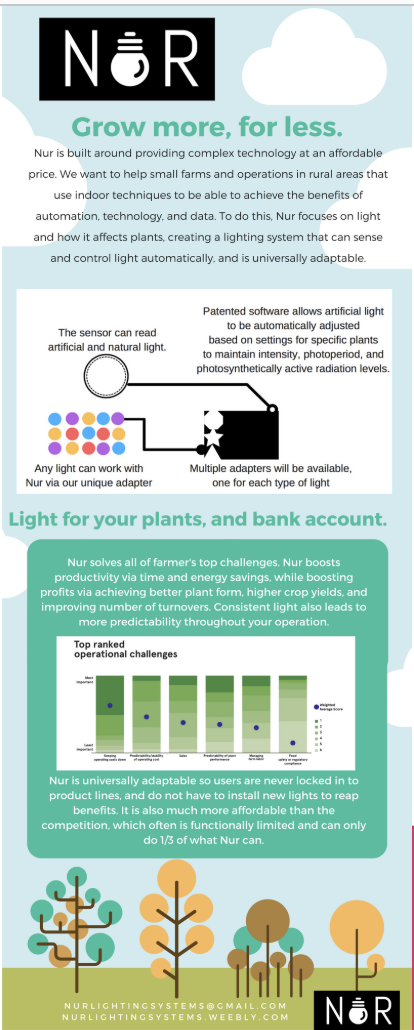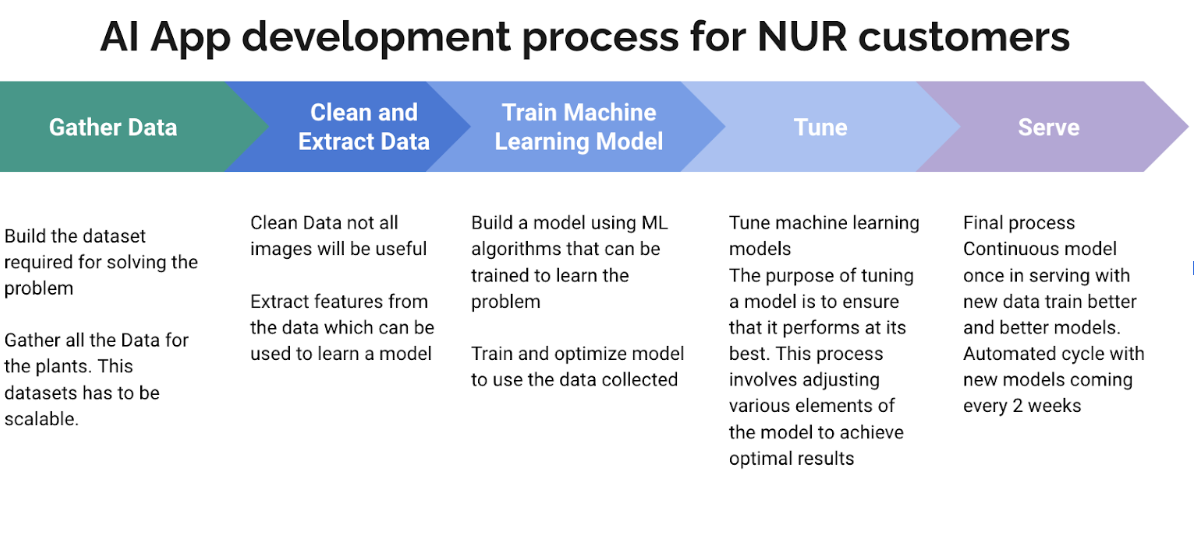
NUR LIGHTING SYSTEM WEBSITE LINK
As an engineering student during my sophomore year, I came up with the idea for Nur Lighting to address a real-world problem I observed in a greenhouse at Oak Creek. Tomato seeds require at least 16 hours of light daily to grow, and during the cold and dim month of February, the greenhouse lights had to be turned on for the full duration, regardless of how much natural light was available. This resulted in significant energy waste and labor inefficiencies, as fluorescent light club members manually turned the lamps off when sunlight was sufficient. However, these efforts were inconsistent and subjective, often harming the plants due to overexposure or inadequate lighting.
I envisioned a smarter system using a photoresistor to sense light levels outside the greenhouse. My design would enable the lights to turn off automatically when the sun shines brightly and turn back on when the sun sets or clouds roll in. A microcontroller would collect data from the photoresistor, calculate the total natural light received, and determine how much supplemental light the plants needed. For instance, if the tomato seeds only received 3 hours of sunlight on a cloudy day, the system would activate LED lights for an additional 13 hours, ensuring optimal growth conditions while lowering energy costs and reducing manual labor.
To develop this idea further, I sought advice from Professor James Cassidy, a Senior Instructor in Soil Physics & Organic Agriculture. After discussing my project with him, I visited the Oak Creek greenhouse to observe the existing setup and identify the specific challenges of growing tomato seeds. The greenhouse had mats and fluorescent lights, but the inefficiencies of the current system were evident. This hands-on research shaped the foundation of Nur Lighting and motivated me to refine my design.
I continued developing and refining this project over my sophomore to senior years, which eventually earned me a spot as a semi-finalist in the Smith College Women Entrepreneurship competition(our roll-up banner to the right).
One memorable moment was when my prototype was damaged in transit from Oregon to Boston. In a rush, I extracted a wire from an LED bracelet five minutes before the competition began, and thankfully, the prototype worked just in time!
Key Components and Their Functions:
LED Current Control
This section regulates the current flowing to the LEDs using transistors and an operational amplifier (INA180B). It ensures stable illumination, critical for plants' growth under artificial lighting.
Light Meter
This part uses a photoresistor or light sensor to measure ambient light levels. The sensor provides data to the microcontroller, enabling real-time adjustments to the LED intensity based on sunlight availability.
36V to 12V Buck Converter
This power regulation circuit steps down a 36V input to a 12V output. It provides a stable power supply to the system, ensuring energy efficiency and protecting components from overvoltage.
Fan Control
This section controls cooling fans to prevent the system from overheating. Using transistors and resistors, it adjusts fan speed based on temperature readings, maintaining optimal operating conditions.
One-Wire Temperature Sensors (DS18B20)
These sensors monitor the temperature inside the greenhouse. Data from the sensors helps ensure the lighting and environment remain within the ideal range for plant growth.
On/Off Timer Control
This circuit automates the timing of the LEDs, ensuring the plants receive the necessary amount of light daily without manual intervention. It calculates supplemental lighting needs based on natural light exposure.
ISP Header and UART
These sections facilitate communication and programming. The ISP header allows for programming the Arduino microcontroller, while UART supports serial communication for data logging and debugging.
Reset Button and Voltage Sensing
The reset button provides a manual system reset, while the voltage-sensing circuit monitors power levels to detect anomalies and ensure consistent operation.
Here are sketches of a diagram of how NUR would look integrated with AI
The Challenge of Ozone: A Dual Role
Ozone is vital in the stratosphere—shielding Earth from harmful UV rays—but becomes a dangerous pollutant in the troposphere. This uneven distribution causes two major issues: depletion leading to increased UV exposure and excess leading to air pollution and health risks.
Innovative Solutions: Tackling Excess Ozone
To combat excess ozone, scientists have developed groundbreaking methods involving "water cannons." These devices create artificial water mists, effectively capturing and reducing ozone levels in the atmosphere. By deploying these systems in offices, urban areas, or even in the troposphere, they can locally decrease ozone concentration. The idea emphasizes a scalable and sustainable approach to environmental challenges.
On an individual level, the solution extends to raising public awareness about ozone exposure. For instance, during hot, windless days, limiting outdoor activities and ensuring access to well-ventilated indoor spaces can mitigate health risks. Timely dissemination of information through the internet and media is equally crucial, empowering people to take preventive measures and reduce their exposure.
The Idea of Balancing Ozone Levels
The concept takes a step further with a device designed to redistribute ozone to areas lacking it. By releasing controlled amounts of ozone into regions with depleted levels, the system seeks to restore balance. This vision aligns with global efforts to combat ozone depletion, aiming for a world where neither ozone holes nor harmful warming prevail.
Additionally, transitioning to eco-friendly practices in areas with low ozone levels—such as reducing the use of aerosols, switching to cleaner energy sources, and adopting sustainable transportation—can gradually rebuild ozone concentration.
Addressing Ozone Depletion
An engineering breakthrough in addressing ozone depletion involves an innovative device designed for generating ozone from oxygen. The apparatus consists of a steel capsule containing a porous catalyst, such as silica gel, and is equipped with cooling and heating mechanisms. By exposing the catalyst to external radiation, the device converts oxygen into ozone efficiently. Despite its promise, the design faces challenges, such as the need for high-energy radiation sources and the complexity of ensuring environmental safety.
To overcome these barriers, the technology focuses on simplifying the process and reducing costs while maintaining high energy efficiency. This balance makes the method accessible for industries like wastewater treatment, air purification, and potable water preparation, where ozone plays a vital role.
The Vision for a Sustainable Future
By combining these technologies with individual action and global collaboration, we can work toward a healthier, more balanced atmosphere—proving humanity’s capacity to innovate and adapt in the face of complex environmental challenges.
This Section celebrates and describes a project for which I got 2nd place in an international physics competition held in Paris.






